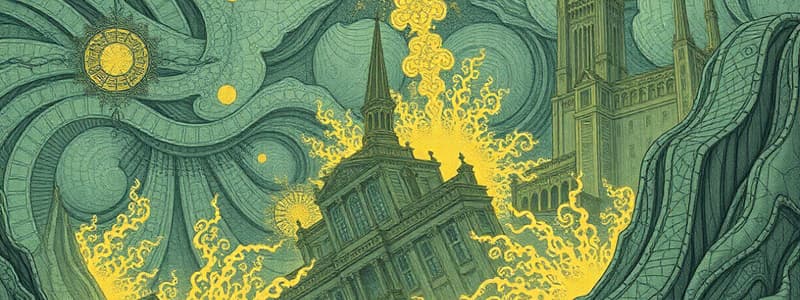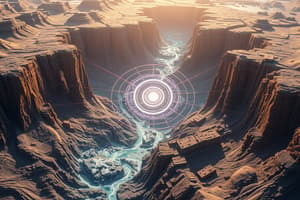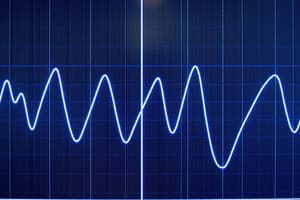Podcast
Questions and Answers
How do scientists categorize shock waves?
How do scientists categorize shock waves?
- Based on their strength relative to other seismic events.
- Based on the depth at which they originate.
- Based on their distance from the epicenter.
- Based on when they occur in relation to the main shock. (correct)
What is a common risk factor that increases the danger to people during an earthquake?
What is a common risk factor that increases the danger to people during an earthquake?
- Being indoors during the earthquake.
- The age and condition of the buildings they occupy. (correct)
- Living in earthquake-prone regions.
- Lack of awareness about earthquake safety measures.
Which of the following is the correct sequence of earthquake events?
Which of the following is the correct sequence of earthquake events?
- Main shock, aftershock, foreshock
- Aftershock, main shock, foreshock
- Foreshock, main shock, aftershock (correct)
- Foreshock, aftershock, main shock
What is the relationship between earthquakes and tsunamis?
What is the relationship between earthquakes and tsunamis?
What contributes to fires occurring after earthquakes?
What contributes to fires occurring after earthquakes?
What distinguishes foreshocks from other types of shock waves?
What distinguishes foreshocks from other types of shock waves?
Besides buildings collapsing, what is another major impact of earthquakes on infrastructure?
Besides buildings collapsing, what is another major impact of earthquakes on infrastructure?
How do aftershocks compare to the main shock in terms of strength?
How do aftershocks compare to the main shock in terms of strength?
In what areas are earthquakes likely to cause flooding?
In what areas are earthquakes likely to cause flooding?
What secondary geological event can earthquakes trigger in mountain areas?
What secondary geological event can earthquakes trigger in mountain areas?
What is the most defining characteristic of the main shock in an earthquake sequence?
What is the most defining characteristic of the main shock in an earthquake sequence?
Considering safety during an earthquake, why are older buildings particularly dangerous?
Considering safety during an earthquake, why are older buildings particularly dangerous?
Which destructive phenomenon is often a direct result of powerful, earthquake-induced sea floor movement?
Which destructive phenomenon is often a direct result of powerful, earthquake-induced sea floor movement?
What is the primary basis for categorizing shock waves following an earthquake?
What is the primary basis for categorizing shock waves following an earthquake?
How can earthquakes lead to landslides and avalanches, especially in mountain areas?
How can earthquakes lead to landslides and avalanches, especially in mountain areas?
If a region experiences a series of tremors, how would you identify which tremor is the 'main shock'?
If a region experiences a series of tremors, how would you identify which tremor is the 'main shock'?
What is a significant cause of damage specifically associated with earthquakes in densely populated coastal regions?
What is a significant cause of damage specifically associated with earthquakes in densely populated coastal regions?
How can earthquakes contribute to the occurrence of fires in affected areas?
How can earthquakes contribute to the occurrence of fires in affected areas?
Why are aftershocks a concern following a major earthquake?
Why are aftershocks a concern following a major earthquake?
What immediate action can earthquakes trigger that poses a risk to people living near mountain areas?
What immediate action can earthquakes trigger that poses a risk to people living near mountain areas?
Flashcards
Foreshocks
Foreshocks
Smaller tremors that precede the main earthquake.
Main Shock
Main Shock
The strongest shock wave of an earthquake, recording the highest score on the Richter scale.
Aftershocks
Aftershocks
Shock waves that follow the main shock of an earthquake.
Tsunamis
Tsunamis
Signup and view all the flashcards
Building Collapse
Building Collapse
Signup and view all the flashcards
Landslides and Avalanches
Landslides and Avalanches
Signup and view all the flashcards
Study Notes
Shocks
- Earthquakes do not always happen with just one shock wave
- The gap between shock waves can be several minutes or days
- Shock waves are divided into foreshocks, main shock, and aftershocks based on when they happen
- Foreshocks are the first tremors people may notice
- The strongest shock wave is the main shock
- Main shocks record the highest score on the Richter scale
- Aftershocks follow the main shock
- Aftershocks can be as strong as the main shock
Damage
- Earthquakes cause a lot of damage
- Shaking ground leads to buildings falling down
- People in old, weak buildings are in the most danger
- Deep cracks sometimes form in the ground
- Earthquakes can ruin roads and stop travel
- Earthquakes sometimes cause flooding in coastal areas
- Earthquakes can sweep houses, cars, and people away
- Landslides and avalanches can occur after earthquakes
- Landslides and avalanches can lead to falling rocks and snow in mountain areas
- Fires can occur after earthquakes when gas pipes and electrical cables are damaged
- Tsunamis, giant waves, can be triggered by powerful earthquakes
- Tsunamis cause major destruction as they wash ashore
Studying That Suits You
Use AI to generate personalized quizzes and flashcards to suit your learning preferences.




